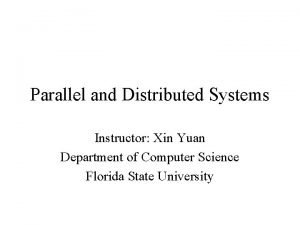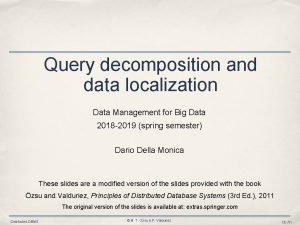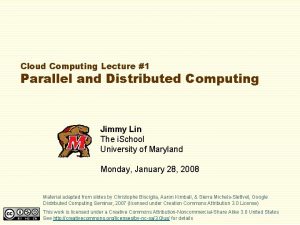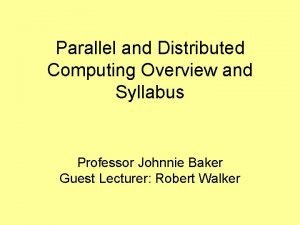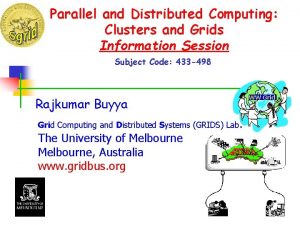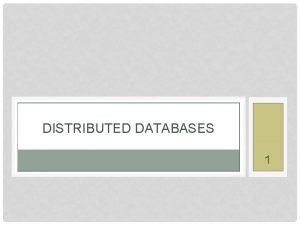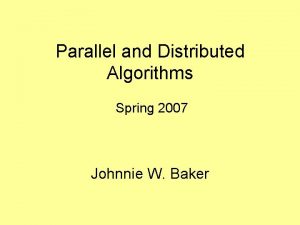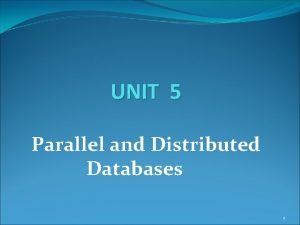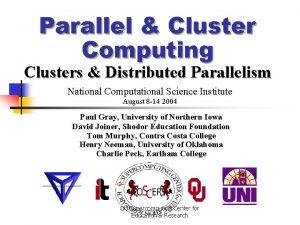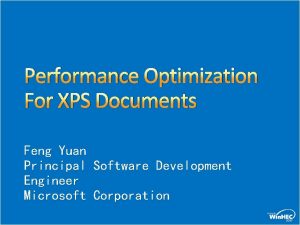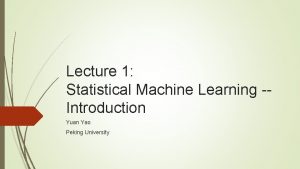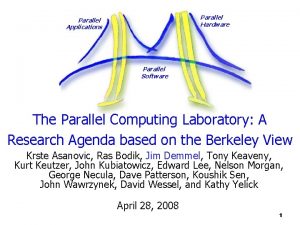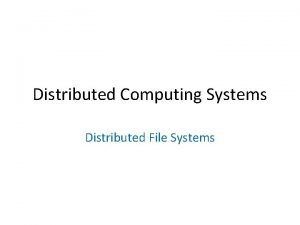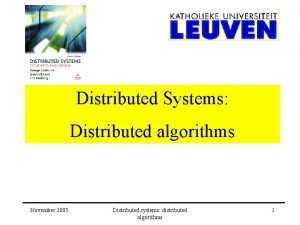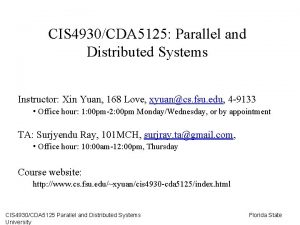Parallel and Distributed Systems Instructor Xin Yuan Department

Parallel and Distributed Systems Instructor: Xin Yuan Department of Computer Science Florida State University

Parallel and distributed systems • What is a parallel computer? – A collection of processing elements that communicate and coorperate to solve large problems fast. • What is a distributed system? – A collection of independent computers that appear to its users as a single coherent system. – A parallel computer is implicitly a distributed system.

What are they? • More than one processing element • Elements communicate and cooperate • Appear as one system • PDS hardware is everywhere. – – diablo. cs. fsu. edu (2 -CPU SMP) Multicore workstations/laptops linprog. cs. fsu. edu (4 -node cluster, 2 -CPU SMP, 8 cores per node) Hadoop clusters – IBM Blue Gene/L at DOE/NNSA/LLNL (262992 processors). – Data centers – SETI@home.

Why parallel and distributed computing? • Moore’s law: the number of transistors double every 18 months.

Why parallel and distributed computing? • How to make good use of the increasing number of transistors on a chip? – Increase the computation width (70’s and 80’s) • 4 bit->8 bit->16 bit->32 bit->64 bit->…. – Instruction level parallelism (90’s) • Pipeline, LIW, etc – ILP to the extreme (early 00’s) • Out of order execution, 6 -way issues, etc – Sequential program performance keeps increasing. • The clock rate keeps increasing, clock cycles get smaller and smaller.

Why parallel and distributed computing? • The fundament limit of the speed of a sequential processor. – Power wall (high frequency results in heat) – Latency wall (speed of light does not change)

Power wall: what will happen if we keep pushing ILP?

Latency wall • Speed of light = 30000 m/s • One cycle at 4 Ghz = 0. 0000025 s • The distance that the light can move at one cycle: – 0. 0000025 * 30000 = 7. 5 cm Intel chip dimension = 1. 47 in x 1. 47 in = 3. 73 cm x 3. 73 cm

Why parallel and distributed computing? • Power wall and latency wall indicate that the era of single thread performance improvement through Moore’s law is ending/has ended. • More transistors on a chip are now applied to increase system throughput, the total number of instructions executed, but not latency, the time for a job to finish. – Improving ILP improves both. – We see a multi-core era

• The marching of multi-core (2004 -now) – Mainstream processors: • • INTEL Quad-core Xeon (4 cores), AMD Quad-core Opteron (4 cores), SUN Niagara (8 cores), IBM Power 6 (2 cores) – Others • Intel Tflops (80 cores) • CISCO CSR-1 (180 cores) (network processors) – Increase throughput without increasing the clock rate.

• Why parallel and distributed computing? – Programming multi-core systems is fundamentally different from programming traditional computers. • Parallelism needs to be explicitly expressed in the program. – This is traditionally referred to as parallel computing. • PDC is not really a choice anymore.
![For (I=0; I<500; I++) a[I] = 0; Performance GO PARALLEL 1970 1980 1990 2006 For (I=0; I<500; I++) a[I] = 0; Performance GO PARALLEL 1970 1980 1990 2006](http://slidetodoc.com/presentation_image_h/f4a3e2003d3e9fcecbdc97f3fc614b71/image-12.jpg)
For (I=0; I<500; I++) a[I] = 0; Performance GO PARALLEL 1970 1980 1990 2006

• In the foreseeable future, parallel systems with multi-core processors are going mainstream. – Lots of hardware, software, and human issues in mainstream parallel/distributed computing • How to make use a large number of processors simultaneously • How to write parallel programs easily and efficiently? • What kind of software supports is needed? • Analyzing and optimizing parallel programs is still a hard problem. • How to debug concurrent program?

Parallel computing issues • Data sharing – single versus multiple address space. • Process coordination – synchronization using locks, messages, and other means. • Distributed versus centralized memory. • Connectivity – single shared bus versus network with many different topologies. • Fault tolerance/reliability.

Distributed systems issues • Transparency – Access (data representation), location, migration, relocation, replication, concurrency, failure, persistence • Scalability – Size, geographically • Reliability/fault tolerance

What we will be doing in this course? • This is the first class in PDC. – Systematically introduce most mainstream parallel computing platforms and programming paradigms. • The coverage is not necessary in depth.
- Slides: 16
